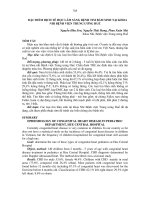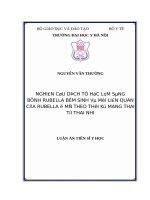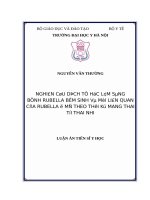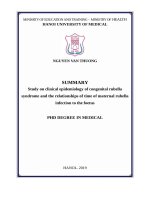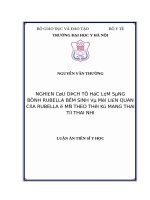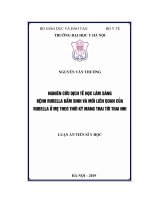Nghiên cứu dịch tễ học lâm sàng bệnh rubella bẩm sinh và mối liên quan của rubella ở mẹ theo thời kỳ mang thai tới thai nhi tt tiếng anh
Bạn đang xem bản rút gọn của tài liệu. Xem và tải ngay bản đầy đủ của tài liệu tại đây (337.97 KB, 28 trang )
MINISRTY OF EDUCATION AND TRAINING - MINISTRY OF HEALTH
HANOI UNIVERSITY OF MEDICAL
NGUYEN VAN THUONG
SUMMARY
Study on clinical epidemiology of congenital rubella
syndrome and the relationships of time of maternal rubella
infection to the foetus
PHD DEGREE IN MEDICAL
HANOI– 2019
MINISRTY OF EDUCATION AND TRAINING - MINISTRY OF HEALTH
HANOI UNIVERSITY OF MEDICAL
==============
NGUYEN VAN THUONG
SUMMARY
Study on clinical epidemiology of congenital rubella
syndrome and the relationships of time of maternal rubella
infection to the foetus
Specialty: Pediatrics
Code: 62720135
PHD DEGREE IN MEDICAL
Supervisor: Asso. Prof. Dr. Nguyen Van Bang
HANOI -2019
THESIS SUMITTED TO HANOI MEDICAL UNIVERSITY
Supervisors:
Asso. Prof. Dr. Nguyen Van Bang
Reviewer 1:
Reviewer 2:
Reviewer 3:
This study is going to be defended before the Doctoral Committee
at……..(d)/…….(m) in 2019
Archived at:
- The National Library of Vietnam
- The Library of Hanoi Medical University
LIST OF PUBLICATION RELATED THE THESIS
1.
2.
3.
4.
5.
6.
7.
Phung Nha Hanh, Nguyen Van Kinh, Nguyen Van Bang, Nguyen Van
Thuong, Pham Danh (2011). Clinical, subclinical characteristics and
consequences of rubella in pregnancy, the first step to evaluate
clinical symptom of congenital rubella. Journal of practical
medicine, No 781.
Nguyen Van Thuong, Triẹu Thi Thai et al (2012). Congenital rubella
syndrome in Ha Noi after rubella outbreak in 2011. Journal of
practical medicine, Volume 80, N03A.
Nguyen Van Bang, Nguyen Thi Van Anh, Vu Thi Tuong Van, Trieu
Thi Hong Thai, Nguyen Van Thuong, Gulam Khandaker, Elizabeth
Elliott (2014). Surveillance of congenital rubella syndrome (CRS) in
tertiary care hospitals in Hanoi, Vietnam during a rubella epidemic.
Vaccine journal 2014.
Nguyen Van Thuong (2015). Evaluation of clinical and subclincal
characteristics of congenital rubella syndrome in young children in
some hospital in Ha Noi. Vietnam journal of Infectious diseases , No
01 (9).
Bang Nguyen Van, Anh Nguyen Thi Van, Van Vu Thi Tuong, Thai
Trieu Thi Hong, Thuong Nguyen Van, Gulam Khandaker, and
Elizabeth Elliott (2015). Serology of rubella and sueveillance of
congenital rubella syndrome in Hanoi where an outbreak has
occurred. Vietnam journal of medicine pharmacy, No 9(3).
Nguyen Van Thuong, Nguyen Van Bang (2018). Relationships
between gestational age at time of maternal rubella and defects in
children. Jornal of community Medicine, No 6 (47), 11-12/2018.
Nguyen Van Thuong, Nguyen Van Bang (2018). Study on clinical
feature in children with congenital rubella syndrome in Ha Noi from
2012 to 2017. Vietnam journal of Infectious diseases, No 1 (25)
1
INTRODUCTION
Rubella is an infectious disease caused by rubella virus, which is
transmitted through the respiratory tract. Rubella infection during
pregnancy periodlead to miscarriage, stillbirth, or a newborn with
congenital rubella syndrome (CRS). Clinical characteristics of CRS
include: low birth weight, microcephaly, ophthalmological abnormalities,
congenital heart disease, hearing impairment, brain damage, etc. In the
world, approximately 100,000 babies suffer from CRS each year, Southeast
Asia is a high-prevalence area with around 46,000 cases of CRS. In
Vietnam, the average annual proportion of CRS is 2.4/100,000 people. The
proportion of CRS ranges from 0.1 to 4 children per 1000 live births.
CRS has many serious consequences. According to Nazme et al.
(2015) 60% of CRS cases were hearing impairment, this figure is 60% of
CRS cases in Hanoi under the research in 2011-2012. Cataract accounts for
35% of CRS cases, our previous research in Hanoi was 46.9%. Nazme et
al. (2015) pointed out that congenital heart disease accounts for 60% and
this figure in our study in Hanoi in 2011-2012 is 63.7%. The association
between gestational age at time of maternal rubella and defects in children
was published in the studies of Peckham et al (1972), Miller (1982),
Ohkusa et al (2014) and Simons (2016).
In Vietnam, currently, there is no adequate studies on clinical
epidemiological characteristics and the effect of gestational age at time of
maternal rubella on defects/morbidity in infants and young children. To
contribute scientific evidence to measures for prevention, diagnosis and
treatment of congenital rubella infection/syndrome we conducted a
research entitled “Study on clinical epidemiology of congenital rubella
syndrome and the relationships of time of maternal rubella infection to
the foetus”, with two following objectives:
1. To describe clinical epidemiological characteristics of congenital
rubella infection/syndrome in infants and young children.
2. To evaluate the relationship between the time of rubella infection
in pregnancy and defect/ morbidity status of the foetus.
New contributions of the thesis:
For the first time in Vietnam, a complete study of clinical
epidemiological characteristics of congenital rubella infection/syndrome in
infants and young children. Clinical characteristicsof postpartum infants
with congenital rubella infection/syndrome: skin hemorrhage (79.6%),
thrombocytopenia (79.3%), jaundice (82.9%), enlarged spleen (31.1%),
enlarged liver (38.5%), low weight (40.5%), premature (25.4%). CRS
2
accounted for 83.6%, of which hearing impairment (79.6%),
ophthalmological abnormalities (23.8%), cerebral palsy (5.7%), congenital
heart disease (40.5%). The follow-up on children with CRI/CRS from birth
to 48 months age of shows that 1.3% of children was died; developmental
disorders: intellectual disability (20%); gross motor delay (68.1%),
language delay (93.6%), final-motor adoptive delay (65.8%), individualsocial delay (59.9%).
Results from our study confirmed a close relationship between the
point of time of maternal rubella infection and (a) postpartum pathological
status in children including: premature, low birth weight, purpura,
thrombocytopenia, jaundice, hepatomegaly, and splenomegaly; (b)
congenital rubella syndrome classic symptoms, including hearing
impairment, eye abnormalites and congenital heart disease; and (c)
developmental disorders including: intellectual disabilities; gross motor
delay, fine-motor delay, phonation and speaking delay, delay in individualsocial interaction, autistic spectrum disorder.
CHAPTER 1. DOCUMENT OVERVIEW
1.1. VIRUS RUBELLA AND RUBELLA DISEASE
1.1.1. History of rubella disease
The first case of rubella was described in 1740, but the rubella virus
was isolated only in 1962. Studies in the US in 1957, in Sweden in 1962,
and in Australia in 1965 showed that CRS was caused by rubella virus
(RV).
1.1.2. Structure and genome of virus rubella
RV is a virus with cover, RNA string is single, ~9,762 nt long. Viron
diameter is 70nm. The lipid envelope contains glycoproteins E1 and E2, a
nucleocapsid, including viral RNA and capsid protein. The glycoprotein E1
of the virus has a transparent structure which differ from the similar
structure in Alphavirus and Flavivirus.
1.1.3. Transmission and disease manifestations
RV is transmitted via respiratory tract, infants with CRI spread RV
from excretory fluids and this process can length up to 1 year after birth.
RV attaches and replicates mainly the nasopharynx, upper respiratory tract
and regional lymph nodes.
Infection with RV may or may not have any special symptoms,
including fever, rash, and joint pain. Infection with RV often has mild
symptoms, severe complications only appear in cases of CRS.
The symptoms of RV infection are similar to Enterovirus,
Adenovirus, Parvovirus B19 and Arbovirus. Therefore, it is necessary to
3
test IgG and IgM, or isolate the virus for disease diagnosis.
1.1.4. Immune reaction and testing for rubella infection
Immune response: erythrocyte mediated antibody, rapidly
developing neutralizing antibody, IgG, IgM specific antibodies a few days
later. Diagnosis of rubella disease: Measure IgG, IgM rubella concentration
by RT-PCR or detect RV in the nasopharynx fluid by virus isolation.
1.2. CHARACTERISTICS OF CLINICAL EPIDEMIOLOGY OF
CONGENITAL RUBELLA INFECTION/SYNDROME
1.2.1. The proportion of congenital rubella infection
The prevalence of CRS is 0.1-0.2 per 1000 live births and from 0.8
to 4.0 per 1000 live births when the outbreak occurred. In Vietnam, the
incidenceof rubella infection is 2.4/100,000 people annually. A research in
Khanh Hoa in 2014 pionted out the prevalence of CRI is 151/100,000 live
births and prevalence of CRS is 234/100,000 live births.
1.2.2. Several studies on clinical epidemiological characteristics of
congenital rubella infection
Clinical characteristics of infants with CRS: premature birth (25%);
Low weight from 25.5% to 86% in numerous studies; Thrombocytopenia
from 74.3% to 85%; neonatal jaundice (88%); enlarged liver from 10 to
20% (according to WHO) and 62.8% (a research in Hanoi).
Birth defects: different results in numerous studies: Hearing
impairment accounts for 5% -100%; Ophthalmological abnormalities
account for 12-100%; congenital heart diseases from 6% -100%; Brain
damage (10-20% meningitis).
Physical and mental development of children with CRS: 95% of
children develop below normal levels according to ASQ or Denver. Autism
spetrum disorder children account for 41%; intellectual disability from 4 to
74%.
1.3. THE RELATIONSHIP BETWEEN THE TIME OF RUBELLA
INFECTION IN PREGNANCY AND DEFECT/MORBIDITY
STATUS OF THE FOETUS WITH CONGENITAL RUBELLA
INFECTION
1.3.1. The mechanism that rubella causes defects to the fetus
RV non-structural P90 and proteins of cells that regulate cell growth
(retinoblastoma protein regulates cell cycle; citron-K protein kinase
regulates cell division) may contribute a role in teratogenicity.
1.3.2. The impact of rubella infection on fetal period according to point
of time of maternal infection during pregnancy
Hearing impairment: The group of children has mothers with
4
rubella infection at 0-8 weeks of pregnancy has 38% of cases with
congenital hearing loss, the group of children has mothers with rubella
infection at 9-16 weeks of pregnancy accounts for 43 % cases with
congenital hearing loss, group of children has mothers with rubella
infection at 17-20 weeks of pregnancy has 1% cases with hearing loss.
Ophthalmological abnormalities: The group of children has mothers
with rubella infection at 0-8 weeks, 9-16 weeksof pregnancy has 12%, 6%
cases with congenital eye disease, respectively. There were no cases of
congenital eye diseases among children whose mothers had rubella
infection after 17 weeks of pregnancy.
Congenital heart disease: The group of children has mothers with
rubella infection at 0-8 weeks, 9-16 weeksof pregnancy has 24%, 9% cases
with congenital heart disease,respectively.
CHAPTER 2. SUBJECTS AND METHODS OF RESEARCH
2.1. RESEARCH SUBJECTS
a)Infants with CRS
- Suspected CRS cases: has or more of the following findings:
+ Groups 1: Cataracts, congenital glaucoma, congenital heart
disease, hearing impairment, pigmentary retinopathy.
+ Group 2: Purpura, hepatosplenomegaly, jaundice, microcephaly,
developmental delay, meningoencephalitis, or radiolucent bone disease.
- Probable CRS cases: Have at least two symptoms in group 1
without a more plausible etiology; or have at least one symtom in groups 1
and one symptom in group 2.
- Confirmed: An infant with at least one of the symptoms clinically
consistent with CRS listed above, and laboratory evidence of congenital
rubella infection.
b) Infants with CRI: An infant without any clinical symptoms or
signs of rubella but with laboratory evidence of infection demonstrated by:
Isolation of RV, detection of rubella-specific IgM antibody, infant rubella
antibody level that persists at a higher level and for a longer period of time
than expected from passive transfer of maternal antibody; a specimen that
is PCR-positive for rubella virus
c) Mothers whose child with CRI or CRS, agreed to participate in
the study.
2.2. RESEARCH METHODOLOGY
2.2.1. Research design
Prospective descriptive case-series combined with longitudinal
follow-up cohort study.
5
2.2.2. Sample size of the study
n: the minimal number of children with congenital rubella
syndrome that needs being in research
= 1,96 (confidence coefficient 95%)
d = 0,006 (Minimum permissible error)
p=0,0025: the rate of congenital rubella syndrome in a previous
study in Vietnam, about 0.1 to 4 infants per 1,000 live births, depending on
specific time, we estimate an average of 2.5 children with congenital
rubella infection per 1,000 live births (equivalent to p = 0.0025).
Replace by the number we have n = 267, to insure 10% of the case
of giving up, the process of selecting sample size for research we collected
data from 299 children with congenital rubella infection.
2.2.3. Research variables and information collection methods
2.2.3.1. Research variables
- General information: Place of residence, gender of children, order of
children in the family.
- Prehistoric characteristics: age of mother when giving birth and mother
vaccinated against rubella, week ofpregnancy that mother was infected
with rubella virus, expression of mother when she was infected with
rubella virus, mother exposed with a personwho is suspected with rubella
virus.
- Clinical manifestations of CRI after childbirth: gestational age at birth,
child weight, infection, respiratory failure, skin purpura, Acute Kidney
Injury, thrombocytopenia, jaundice, enlarged spleen, enlarged liver.
- Postpartum interventions: Ventilator, dialysis, blood transfusion, platelet
transfusion.
- Congenital defects: Hearing impairment, Ophthalmological abnormalities,
brain damage, congenital heart diseases.
- Developmental disorders: intellectual disabilities; gross motor delay,
final-motor adoptive delay, phonation and speaking delay, individual-social
interaction delay, autistic sepctrum disorder.
2.2.3.2. Methods of information collection
- Interview with the patient's mother
- Clinical examination of newborns
6
- Specialist examination of ophthalmology, ENT, cardiology.
- IgM and IgG tests.
- Monitoring and evaluating development disorders
2.3. MANAGEMENT AND DATA ANALYSIS
Data processing with software STATA 12.0
2.4. ETHICS IN RESEARCH
Research complies with the ethical principles of Hanoi Medical
University and ensure the confidentiality of patient’s information under
regulations.
CHAPTER 3. RESEARCH RESULTS
3.1. CHARACTERISTICS OF CLINICAL EPIDEMIOLOGY OF
CONGENITAL RUBELLA INFECTION/SYNDROME IN INFANTS
AND YOUNG CHILDREN
3.1.1. Demographic characteristics of infants and young children with
congenital rubella infection/syndrome
3.1.2. Prehistoric characteristics of mothers of infants and young
children with congenital rubella infection/syndrome
3.1.3. Postpartum clinical manifestations in children with congenital
rubella infection/syndrome
Table 3.1. Gestational age and birth weight
Characteristics
Quantity
Percentage %
Premature birth
76/299
25.4
Underweight newborns
121/299
40.5
Table 3.2. The proportion of some postpartum clinical manifestations
Characteristics
Quantity
Percentage %
Infection
7/299
2.3
Respiratory failure
18/299
6.0
Skin purpura
238/299
79.6
Acute Kidney Injury
4/299
1.3
Thrombocytopenia
237/299
79.3
Pathological jaundice
248/299
82.9
Enlarged liver
115/299
38.5
Enlarged spleen
93/299
31.1
7
Chart 3.1. The incidence of congenital rubella syndrome
Table 3.3. Postpartum intervention among the infants
and children
Intervention
Quantity
Percentage %
Ventilator
19/299
6.4
Dialysis
1/299
0.3
Blood transfusion
17/299
5.7
Platelet transfusions
15/299
5.0
Chart 3.2. The rate of hearing impairment
Table 3.4. Congenital heart diseases
Congenital heart diseases
Quantity Percentage %
Pathological arterial duct
64/299
21.4
Ventricular septal
7/299
2.3
Atrial septal
1/299
0.3
Regurgitation
22/299
7.4
Pulmonary artery stenosis
30/299
10.0
Others
2/299
0.7
8
Table 3.5. The rate of combined defects
Diseases/malformations
Frequency
Normal
Only hearing impairment
Only heart diseases
Only ophthalmological abnormalities
Hearing impairment +heart disease
Hearing impairment + ophthalmological
abnormalities
Ophthalmological abnormalities + heart disease
Hearing impairment + heart disease +
ophthalmological abnormalities
11
115
8
0
47
3
13
53
Percentage
%
4.4
46.0
3.2
0
18.8
1.2
5.2
21.2
Chart 3.3. Mortality rate in children after 4 years of follow-up
Chart 3.4. The rate of intellectual disabilities
9
Chart 3.5. Gross motor delay by age
Chart 3.6. Phonation and speaking delay by age
Table 3.6. The rate of language delay
Speaking problem
Quantily The percentage %
General assessment of
No
19
6,4
language delay
Yes
276
93,6
No
270
91,5
Dumb (haven't said anything yet)
Yes
25
8,5
Total
295
100
Chart 3.7. Fine motor delay by age
10
Chart 3.8. Delay of personal-social interaction by age
Chart 3.9. Autistic spectrum disorder
3.2. THE RELATIONSHIP BETWEEN THE TIME OF RUBELLA
INFECTION IN PREGNANCY AND DEFECT/ MORBIDITY
STATUS OF THE FOETUS WITH CONGENITAL RUBELLA
INFECTION
3.2.1. The relationship between the time of rubella infection during
pregnancy and postpartum clinical manifestations
Table 3.7. The relationship between the time of maternal rubella
infection and premature birth
Gestational age at birth
RR
Rubella infection
(95%CI)
<37
weeks
≥37
weeks
during pregnancy
n
%
n
%
≥17 weeks
9
19.6
37
80.4
1
9-16 weeks
36
21.1
135
78.9 1,07 (0,56-2,06)
0-8 weeks
31
37.8
51
62.2 1,93 (1,01-3,70)
Total
76
27.24
203
72.76
-
11
Table 3.8. The relationship between the time of maternal rubella
infection and low birth weight
birth weight
Rubella infection
RR
during
<2500g
≥2500g
(95%CI)
pregnancy
n
%
n
%
≥17 weeks
7
15.2
39
84.8
1
9-16 weeks
65
38.0
106
62.0
2.50 (1.23-5.07)
0-8 weeks
49
59.8
33
40.2
3.93(1.94-7.95)
Total
121
40.5
178
59.5
Table 3.9. The relationship between the time of maternal rubella
infection and neonatal skin purpura
Neonatal skin purpura
Rubella infection
RR
Yes
No
during pregnancy
(95%CI)
n
%
n
%
≥17 weeks
18
39.1
28
60.9
1
9-16 weeks
143
83.6
28
16.4
2,14 (1,48-3,08)
0-8 weeks
77
93.9
5
6.1
2,40 (1,67-3,46)
Total
238
79,6
61
20,4
Table 3.10. The relationship between the time of time of maternal
rubella infection and thrombocytopenia after birth
Thrombocytopenia
Rubella infection
RR
Yes
No
during pregnancy
(95%CI)
n
%
n
%
≥17 weeks
18
39.1
28
60.9
1
14
9-16 weeks
83.0
29
17.0
2,12 (1,47-3,06)
2
0-8 weeks
77
93.9
5
6.1
2,40 (1,67-3,46)
Total
237 79.3
62
20.7
-
12
Table 3.11. The relationship between the time of time of maternal
rubella infection and neonatal jaundice
Neonatal jaundice
Rubella
RR
infection during
Yes
No
(95%CI)
pregnancy
n
%
n
%
≥17 weeks
23
50.0
23
50.0
1
9-16 weeks
146
85.4
25
14.6
1,71 (1,27-2,29)
0-8 weeks
79
96.3
3
3.7
1,93 (1,44-2,58)
Total
248
82.9
51
17.1
Table 3.12. The relationship between the time of maternal rubella
infection and enlarged liver
Enlarged liver
Rubella infection
RR
during
Yes
No
(95%CI)
pregnancy
n
%
n
%
≥17 weeks
13
28.3
33
71.7
1
9-16 weeks
60
35.1
111
64.9
1,24 (0,75-2,05)
0-8 weeks
42
51.2
40
48.8
1,81 (1,09-3,01)
Total
115
38.5
184
61.5
Table 3.13. The relationship between the time of maternal rubella
infection and enlarged spleen
Enlarged spleen
Rubella infection
RR
Yes
No
during pregnancy
(95%CI)
n
%
n
%
≥17 weeks
7
15.2
39
84.8
1
9-16 weeks
52
30.4
119
69.6
2,00 (0,97-4,10)
0-8 weeks
34
41.5
48
58.5
2,72 (1,31-5,65)
Total
93
31.1
206
68.9
-
Table 3.14. Relationship between the time of maternal rubella infection
and CRS
13
Rubella infection
during
pregnancy
≥17 weeks
9-16 weeks
0-8 weeks
Total
Congenital rubella syndrome
Yes
n
25
14
6
79
250
No
RR
(95%CI)
%
54,4
n
21
%
45,6
1
85,4
25
14,6
1,57 (1,20-2,06)
96,3
83,6
3
49
3,7
16,4
1,77 (1,36-3,32)
-
3.2.2. Relationship between the period of maternal rubella infection
and defects in children
Table 3.15. Relationship between the time of maternal rubella infection
and hearing impairment
Hearing impairment
RR
Rubella infection
(95%CI)
Yes
No
during pregnancy
n
%
n
%
≥17 weeks
18
39.1
28
60.9
1
14
9-16 weeks
86.6
23
13.4
2,21 (1,54-3,19)
8
0-8 weeks
72
87.8
10
12.2
2,24 (1,55-3,25)
Total
238 79.6
61
20.4
Table 3.16. Relationship between the time of maternal rubella infection
and cataract
Rubella infection
Cataract
RR
during pregnancy
(95%CI)
Yes
No
n
%
n
%
≥17 weeks
1
2.2
45
97.8
1
9-16 weeks
35 20.5
136
79.5
9,42 (1,32-66,90)
0-8 weeks
32 39.0
50
61.0
17,95 (2,54-127,10)
Total
68 22.74
231
77.3
-
14
Table 3.17. Relationship between the time of maternal rubella infection
and congenital heart disease
Congenital heart disease
Rubella infection
RR
Yes
No
during pregnancy
(95%CI)
n
%
n
%
≥17 weeks
5
10.9
41
89.1
1
9-16 weeks
65
38.0
106
62.0
3,50 (1,50-8,18)
0-8 weeks
51
62.2
31
37.8
5,72 (2,46-13,31)
Total
121
40,5
178
59.5
-
Table 3.18. Relationship between the time of maternal rubella infection
and pulmonary ductus arteriosus
Pulmonary ductus arteriosus
Rubella
RR
infection during
Yes
No
(95%CI)
pregnancy
n
%
n
%
≥17 weeks
1
2.2
45
97.8
1
9-16 weeks
37
21.6
134
78.4
9,95 (1,40-70,62)
0-8 weeks
26
31.7
56
68.3
14,59 (2,05-104,00)
Total
64 21.40
235
78.6
Table 3.19. Combination of birth defects according to the time of
maternal rubella infection
Rubella infection during
pregnancy (weeks)
Total
0-8
9-16
≥17
Defects
n (%)
n (%)
n (%)
n (%)
Normal
2 (18,8)
2 (18,8)
7 (63,6)
11 (4,4)
115
Hearing impairment
24 (20,9) 78 (67,8) 13 (11,3)
(46,0)
Heart diseases
2 (25)
4 (50)
2(25)
8 (3,2)
Hearing impairment + heart
18 (38,3) 27 (57,5)
2 (4,3)
47 (18,8)
diseases
Hearing impairment +
2 (66,7)
1(33,3)
0 (0)
3 (1,2)
ophthalmological abnormalities
Ophthalmological
6 (46,2)
7(53,9)
0 (0)
13 (5,2)
abnormalities + heart diseases
15
Hearing impairment +heart
diseases + 0phthalmological
abnormalities
Total
25 (47,2)
27(50,9)
1 (1,9)
53 (21,2)
79(31,6)
146 (58,4)
25 (10,0)
250 (100)
3.2.3. The relationship between the time of rubella infection in
pregnancy and development disorders in children
Table 3.20. The relationship between the time of maternal rubella
infection and intellectual disability
Intellectual disability
Rubella
infection during
Yes
No
RR (95%CI)
pregnancy
n
%
n
%
≥17 weeks
3
6.5
43
93.5
1
9-16 weeks
35
20.5
136
79.5
3,14 (1,01-9,75)
4,13 (1,300-8 weeks
21
26.9
57
73.1
13,08)
Total
59
20.0
236
80.0
Table 3. 21. The relationship between the time of maternal rubella
infection and gross motor delay in children
gross motor delay
Rubella infection
RR
Delay
Normal
during pregnancy
(95%CI)
n
%
n
%
≥17 weeks
22
47.8
24
52.2
1
12
9-16 weeks
70.8
50
29.2
1,48 (1,08-2,03)
1
1,55 (1,120-8 weeks
58
74.4
20
25.6
2,16)
Total
201
68.1
94
31.9
Table 3.22. The relationship between the time of maternal rubella
infection and fine motor delay in children
Fine-motor delay
Rubella infection
Delay
Normal
RR (95%CI)
during pregnancy
n
%
n
%
≥17 weeks
3
6.5
43
93.5
1
9-16 weeks
59
34.5
112
65.5 5,29 (1,74-16,11)
16
0-8 weeks
39
50.0
39
50.0
Total
101
34.24
194
65.76
7,67 (2,5123,41)
-
Table 3.23. The relationship between the time of maternal rubella
infection and language delay
Language delay
RR
Rubella infection
(95%CI)
Delay
Normal
during pregnancy
n
%
n
%
≥17 weeks
35
76.1
11
23.9
1
16
9-16 weeks
97.1
5
2.9
1,28 (1,08-1,50)
6
0-8 weeks
75
96.2
3
3.8
1,26 (1,07-1,49)
Total
276 93.6
19
6.4
Table 3.24. The relationship between the time of maternal rubella
infection and individual-social delay
Individual-social interaction
Rubella infection
delay
RR
during
Slow
Normal
(95%CI)
pregnancy
n
%
n
%
≥17 weeks
9
19.6
37
80.4
1
9-16 weeks
105
61.4
66
38.6 3,14 (1,73-5,71)
0-8 weeks
65
79.3
17
20.7 4,05 (2,23-7,36)
Total
179
59.9
120
40.1
Table 3.25. The relationship between the time of maternal rubella
infection and autistic spectrum disorder in children
Autistic spectrum disorder
RR
Rubella infection
(95%CI)
Yes
No
during pregnancy
n
%
n
%
≥17 weeks
4
8.7
42
91.3
1
9-16 weeks
56
32.7
115
67.3
3,77 (1,44-9,84)
0-8 weeks
39
50.0
39
50.0
5,75 (2,20-15,05)
Total
99
33.6
196
66.4
-
17
CHAPTER 4. DISCUSSION
4.1. CHARACTERISTICS OF CLINICAL EPIDEMIOLOGY OF
CONGENITAL RUBELLA INFECTION/SYNDROME IN INFANTS
AND YOUNG CHILDREN
4.1.1. Demographic characteristics of infants and young children with
congenital rubella infection/syndrome
4.1.2. Prehistoric characteristics of mothers of infants and young
children with congenital rubella infection/syndrome
4.1.3. Postpartum clinical manifestations in children with congenital
rubella infection/syndrome
* Gestational age and birth weight
Our study result was similar to Sugishita (2015), infants with CRS
are premature birth accounted for 25%. It was lower than previous research
in Hanoi in 2011-2012, low birth weight babies with CRS were born was
86%.
Our result was higher than that of Nguyen Quang Bac’s research,
low birth weight newborns with CRS accounted 25.5%. It was lower
compared with Sugishita et al. (2015) low birth weight infants with CRS
accounted for 68.8%. Our result was higher than Nazme et al. (2015), 23%
of children with CRS were born with low birth weight.
* Clinical manifestations:
Our study results was similar to a research in Hanoi in 2011-2012,
children with CRS have a skin purpura after birth was 74.3%. It was lower
compared to Nguyen Quang Bac (2012) the percentage of newborns with
CRS have skin purpura was 88%, have jaundice was 88%.
Research in 2011-2012 in Hanoi, children with CRS have enlarged
liver accounted for 62.8%, enlarged spleen accounted for 63.7%. It was
lower compared to Nguyen Quang Bac (2012), infants with CRS have
enlarged liver accounted for 56%. According to Reef et al. (2000) and
WHO (2008), enlarged liver and enlarged spleen accounted for
approximately 10-20% of children with CRS.
* The incidence of congenital rubella syndrome:
Our study result was similar to the results of Dontigny et al. (2008), Miller
18
et al (1982); Peckham et al (1972), Ohkusa et al. (2014), Simons et al.
(2014).
* Some postpartum clinical interventions
Intervention rate in our study result was lower than Nguyen Quang
Bac’s research, 12/25 children with CRS decreasedplatelet, especially 7
children with platelets level was below 25G/L, blood transfusion was
forced. There are 4/25 babies died after birth due to very severe status,
multiple deformities, and on CT scans, there were infarctions in the
sinistrocerebral. There are 15/39 children with CRI must be resuscitated
immediately after birth because of fetal distress, fetal growth retardation
and developmental delay in intrauterine.
4.1.4. Birth defects
* Hearing impairment
According to Simons (2016) the percentage of hearing loss has a
different rate in different study populations, accounting for 4-100%. Our
study result was higher than Nazme et al. (2015) with 60% of children with
CRS have hearing loss. It was higher than previous results in Hanoi in
2011-2012, hearing loss accounted for 63.7% of children with CRS.
* Ophthalmological abnormalities
According to Simons (2016) congenital eye diseases have different
rates in different populations and accounted for 12-100% of children with
CRS. Our result was higher than that of a systematic review of Nazme et al.
(2015), the rate of children with CRS had cataract was 25%. Our study
result was lower compared to the previous study result in Hanoi in 20112012, with 46.9% of children with CRS met Ophthalmological
abnormalities. Our study result was also different from Nguyen Quang Bac
(2012) children with CRS had congenital glaucoma, cataract, pigmentary
retinopathy accouted for 12%, 44%, 4%, repectively.
* Cerebral palsy: Our study result was higher than that of a research
of Peckham (1972), the rate of children with positive rubella antibodies
have congenital cerebral palsy accounted for 2.22%.
Congenital heart diseases: Simons (2016) illustrated the percentage of
congenital heart diseases in children with CRS had different rates in
populations and accounted for 6-100%. Our results are lower compared to
the results a research in 2011-2012 in Hanoi, congenital heart diseases in
children with CRS was 63.7%. This rate was lower compared to Nguyen
Quang Bac (2012), children with CRS had heart diseases accounted for
72%, pulmonary artery stenosis accounted for 56%. It was also lower
compared to the research’s result of Sugishitavà et al (2015), the rate of
19
children with CRS have congenital heart diseases was 75%, in which had
arterial duct accounted for 56.3%, pulmonary artery stenosis accounted for
12.5%, ventricular septal defect accounted for 6.3%, and narrowing of the
aorta’s waist accounted for 6.3%. Our study result was lower compared to
Nazme et al. (2015), 60% of children with CRS had heart diseases, most
heart diseases were pathological arterial duct and pulmonary artery stenosis
* Percentage of children with rubella syndrome with combination of
disabilities: Our study result was similar to Simons (2016), children with
CRS had hearing impairment accounted for highest rate with 61%; the
percentage of children with CRS have congenital heart disease was only
9%, only 1 case with CRS has ophthalmological abnormalities accounted
for 1%. Children with CRS have a combination of disabilities: in which
hearing impairment combined with heart diseases accounted for the highest
rate with 12%, Hearing impairment combined with ophthalmological
abnormalities accounted for 4%; The combination of congenital heart and
ophthalmological abnormalities accounted for 7%; The combination of all
3 defectsaccounted for 5% of total children with CRS.
4.1.5. Developmental follow-up of children with congenital rubella
infection
Death in our study was similar to that of a study in 1976-1978, with
2 years of follow-up, 2% of newborns died; in Poland in 1985-1986, with 7
years of follow-up, this figure was 7%; in New York from 1949-1955, after
1 year of follow-up, the rate of dealth cases was 3%; in England from 1950
to 1952 with 2 years of follow-up, this figure was 4%; in Australia after
0.67-4 years of follow-up, there was 2% dealth cases; in New York from
1957-1964 after 5 years of follow-up,the rate of dealth cases was 1%; in
Taiwan from 1957-1958 after 5.5 years of follow-up,it was 6%; in New
Zealand after 0.8-2 years of follow-up,it was 6%; in 11 regions in the US
after 0.07 years of follow-up it was 2%.
The intellectula disability was different in different populations and
accounted for 4-74% of children CRS according to Simons (2016).
The rate of gross motor delay in our study was different from that of
Toizumi M et al (2017), after 2 years of follow up, rate of gross motor
delay of 2013 was 35%, and this figure of 2015 was 45%.
The rate of final-motor adoptive delay in their study is different from
Toizumi M et al (2017), around 30% children hadfinal-motor adoptive
delay in 2013, and it was more than 30% by 2015.
The rate of children with CRS having language delay in our study
result was similar to that of Toizumi M et al (2017), in 2013, this figure
20
was about 75%, by 2015 it was nearly 70%.
The rate of individual-social delay in our research was different from
Toizumi M et al (2017), in 2013, the rate accounted for about 35%, by 2015
this rate is 45%.
Our result was similar to that of Toizumi M and his colleagues
(2017), 95%children with CRS havebelow normal development level under
ASQ scale or Denver II scale.
The pecentage of Autism in our study resultwas lower compared to
research’s result of Toizumi M and colleagues (2017) with 35% of children
with CRS had autism spectrum disorder.
4.2. THE RELATIONSHIP BETWEEN THE TIME OF
RUBELLA INFECTION IN PREGNANCY AND DEFECT/
MORBIDITY STATUS OF THE FOETUS WITH CONGENITAL
RUBELLA INFECTION
4.2.1. The relationship between the time of rubella infection during
pregnancy mother to postpartum clinical manifestations
In our study, there was statistically significant difference between
timing of maternal rubella infection druring pregnancy and neonates with
premature birth (p = 0.01). In which, the risk of premature birth in neonates
whose mothers were infected RV period 0-8 weeks of pregnancy compared
with period ≥17 weeks of pregnancy with RR = 1.92 (95% CI 1.01-3,70).
The study showed a significantly different risk of low birth weight in
neonates between timing of maternal rubella infection during pregnancy (p
<0.001). In particular, the risk of low birth weight in neonates whose
mothers were infected RV period 0-8 weeks of pregnancy and period 9-16
weeks of pregnancy compared with period ≥17 weeks with RR = 3,93
(95%1.23-5.07) and RR = 2.50 (95% CI 1.23-5.07), respectively.
There was a difference in the risk of neonatal skin purpura by timing
of maternal rubella infection during pregnancy (p <0.001). In particular, the
risk of postpartum skin purpura in the group of neonates whose mothers
infected RV period 0-8 weeks of pregnancy and period 9-16 weeks of
pregnancy was higher than period ≥17 weeks of pregnancy with RR = 2.40
(95% CI 1.67-3.46) and RR = 2.14 (95% CI 1.48-3.08), respectively.
The study showed a significantly difference in the risk of
thrombocytopenia by timing of maternal rubella infection during pregnancy
(p <0.001). In particular, the risk of thrombocytopenia in neonates whose
mothers were infected with RV period 0-8 weeks of pregnancy and period
9-16 weeks of pregnancy was higher than group with mother was infected
RV period ≥17 weeks of pregnancy with RR = 2.40 (95% CI 1.67-3.46) and
21
RR = 2.12 (95% CI 1.47-3.06), respectively.
In the study, there was a significantly difference in the risk of
neonatal jaundice by timing of maternal rubella infection during pregnancy
(p <0.001). In particular, the risk of postpartum jaundice in the group of
neonates whose mothers were infected with RV period 0-8 weeks of
pregnancy and period 9-16 weeks of pregnancy was higher than that in
children whose mothers were infected with RV period ≥17 weeks of
pregnancy with RR = 1.93 (95% CI 1.44-2.58) and RR = 1.71 (95% CI
1.27-2.29), respectively.
The analysis showed a difference in the risk of enlarged liver after
birth by timing of maternal rubella infection during pregnancy (p = 0.014).
In which, the risk of postpartum enlarged liver in the group of neonates
whose mothers were infected with RV period 0-8 weeks of pregnancy was
1.81 times higher (95% CI: 1.09-3.01) compared to the group of neonates
whose mothers were infected with RV period 9-16 weeks of pregnancy.
The results of the study also illustrated that the risk of enlarged
spleen was different by timing of maternal rubella infection during
pregnancy (p = 0.008). In particular, the risk of enlarged spleen in the
group of neonates whose mothers were infected RV period 0-8 weeks of
pregnancy, and 9-16 weeks of pregnancy was higher than the group of
neonates whose mothers were infected with RV at ≥17 weeks of pregnancy
with RR = 2.72 (95% CI 1.31-5.65) and RR = 2.00 (95% CI 0.97-4.10),
respectively.
The risk of CRS in children was different by the timing of maternal
rubella infection during pregnancy (p <0.001). In particular, the risk of
CRS in the group of in neonates whose mothers were infected with RV
period 0-8 weeks of pregnancy, and period 9-16 weeks of pregnancy was
higher than that of neonates whose mothers were infected with RV period
≥17 weeks of pregnancy with RR=2.24 (95%CI 1.55-3.25) and RR=2.21
(1.54-3.19), respectively. This figure was similar results from researchs of
Dontigny et al. (2008), Miller et al (1982); Peckham et al (1972), Ohkusa Y
et al (2014) and Simons et al (2014).
4.2.2. Relationship between the period of maternal rubella
infection and congenital defects in children
The study showed that there was a significantly difference in the risk
of hearing impairment by timing of maternal rubella infection during
pregnancy (p <0.001). Our research result was similar to Peckham et al.
(1972), was different from Simons et al. (2016). In our study, the risk of
hearing impairment in the group of children whose mothers were infected




